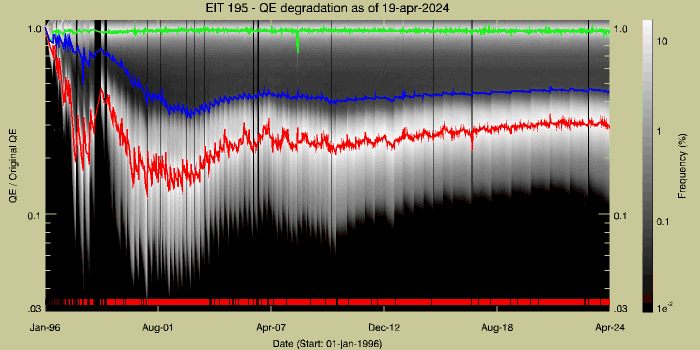

This plot shows the evolution of the QE of the EIT CCD at 19.5 nm as a function of time. For each day is plotted in gray scale the histogram of the EUV flat-field derived from calibration lamps images (equivalent to the flat-field returned by the eit_norm_response.pro routine). The scale bar on the right gives the fraction of the CCD affected by a given degradation. Because the on-disk pixels systematically recieve a higher EUV dose than the off-disk pixels, the CCD has evolved two separate populations of weakly and strongly degraded pixels. Each histogram has two distinct peaks corresponding to these two populations. The green curve corresponds to the most probable value of the population of the least degraded pixels (i.e. the maximum of top peak), while the red curve traces the most probable value of the population of the most degraded pixels (the maximum of the bottom peak). The blue curve represents the median values of the histograms. Finally, the red ticks mark the dates of calibration lamps. The flatness of the green curve indicates that the least degraded pixels indeed show very little degradation, if any. On the other hand, the red curve, and more generally the lower part of the histograms, corresponding to the population of the most degraded pixels, shows large variations. One can see that the width of this population tends to augment during each inter-bakeout period, and on the long term. This is an indication that more and more pixels are significantly degraded, although this trend was temporarily reversed during the decline of solar cycle 23 (2003 - 2007).
Since the SOHO high-gain antenna (HGA) has been forced to remain fixed in the east-west plane starting in 2003 May, the duration of the bakeouts increased significantly, and the population of most degraded pixels slowly improved over those years, which also saw significantly less total EUV exposure than during solar maximum.
Last revised: Friday, October 30, 2015 11:56 AM - F. Auchère